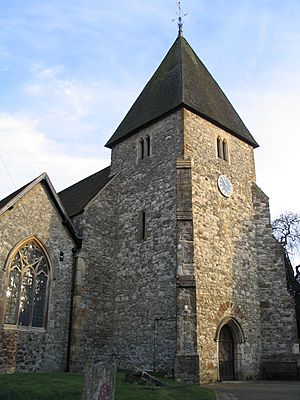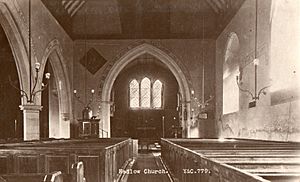St Mary's Church, Hadlow facts for kids
Quick facts for kids St Mary's, Hadlow |
|
|---|---|

St Mary's, Hadlow
|
|
| 51°13′24″N 0°20′22″E / 51.22333°N 0.33944°E | |
| OS grid reference | TQ 6343 4971 |
| Location | Hadlow, Kent |
| Country | England |
| Denomination | Church of England |
| Churchmanship | Liberal Catholic |
| Website | www.stmaryshadlow.org.uk |
| History | |
| Status | Church |
| Founded | 975 |
| Dedication | St Mary |
| Architecture | |
| Functional status | Active |
| Heritage designation | Grade II* listed |
| Designated | 20 October 1954 |
| Architectural type | Church |
| Style | Early English Decorated |
| Specifications | |
| Number of spires | 1 |
| Administration | |
| Parish | Hadlow |
| Deanery | Paddock Wood |
| Archdeaconry | Tonbridge |
| Diocese | Rochester |
| Province | Canterbury |
St Mary's Church is a very old and important church located in Hadlow, a village in Kent, England. It's known as a "parish church," which means it serves the local community. This church is also a "Grade II* listed building," which means it's a special historical building protected by law because of its importance.
Contents
History of St Mary's Church
The first church in Hadlow was mentioned way back in 975. It was likely made of wood. Later, around 1018, a stronger stone church was built in its place.
Building and Ownership Changes
In the 12th century, the church was rebuilt and made bigger by Richard de Clare. He was the lord of Hadlow at the time. In 1166, de Clare gave the church to the Knights Hospitallers. This was a famous group of knights who helped pilgrims and the sick. They had a local base nearby at West Peckham.
For many centuries, Hadlow didn't have a local lord living there. The church remained under the Knights Hospitallers until 1540. At that time, King Henry VIII closed down their order.
Medieval Church Features
It is believed that the church tower was made taller and a spire was added in the 15th century. People often left money in their wills to help maintain the church. For example, in 1448, Thomas Walter left money to create a window on the north side of the church. In 1456, Richard Bealde left money to fix the church tower. In 1509, Thomas Fisher left money to build a new "rood loft," which was a special screen in the church.
Later Repairs and Additions
The west door of the church has the initials "WB ES 1637" carved into it. These initials belong to Walter Barton and Essau Simmons, who were churchwardens that year when the tower and steeple were repaired.
In 1791, a clock made by John Thwaites was put into the tower. By the early 1800s, the church needed a lot of repairs. The chancel (the area around the altar) was rebuilt in 1847, and a vestry (a room for clergy) was added. In 1853, the north aisle was added, costing £470, which was raised by people donating money.
Walter Barton May, who owned Hadlow Castle, built a private gallery inside the church. It had its own entrance and was located at the west end of the main part of the church. This gallery was removed in 1936.
In 1885, a special altar decoration called a reredos was put up. It was in memory of Sir William Yardley, a judge from India, and his wife.
Ancient Carvings Discovered
During work on the church's west doorway in 1936, some small crosses carved into the stone were found. These crosses are thought to have been carved by Nicholas de Hadloe and his son. They lived at Hadlow Place and carved the crosses to celebrate their safe return from the Third Crusade in 1189.
St Mary's Church was officially recognized as a "listed building" on October 20, 1954. It is currently a Grade II* listed building, meaning it's very important historically.
Church Construction and Style
St Mary's Church is mostly built from a type of stone called ragstone. It also has some smooth, cut stone details and corner stones made of Tunbridge Wells sandstone. The church is built in the Early English and Decorated styles, which are types of Gothic architecture.
The roof over the chancel is made of slate, while the roofs over the main part of the church and the aisles are covered with tiles. The spire is covered in shingles, which are like wooden tiles. The beautiful stained glass windows in the church were added in the 19th and 20th centuries. The newest one, called "The Visitation," was made by Francis Skeat in 1956.
The Coverdale Chair
In 1919, a special chair known as the Coverdale Chair was given to St Mary's Church. It was presented by T E Foster MacGeagh, who lived at Hadlow Castle. The chair is named after Miles Coverdale, who was a bishop and created the first full translation of the Bible into English.
In 1954, the chair was moved to Rochester Cathedral. However, it was returned to St Mary's Church in 1967, where it remains today.
Church Bells
St Mary's Church has a set of eight bells that are used for change ringing. This is a special way of ringing bells in a changing pattern.
The first two bells were originally made in 1775. They were recast, or melted down and remade, in 1994 by the Whitechapel Bell Foundry in London. At that time, the third bell was repaired, and the bell frame was replaced. The third bell was made in 1696. The fourth, fifth, sixth, and seventh bells were all made in 1695. The largest bell, called the tenor, was also made in 1695.
The Church Organ
The organ at St Mary's Church was a gift from Ernest Hargreaves in 1880. It was built by Alfred Monk of Camden. A brass plate on the organ has a quote from Psalm 150:
The organ has 35 "speaking stops," which are controls that change the sound of the organ. It has three keyboards for the hands (manuals) and one for the feet (pedal). It can make many different sounds, including loud principal sounds, soft flute sounds, and even a very deep 32-foot contrabass sound.
Organ Restoration
The organ was greatly restored in 1975 by Hill, Norman and Beard. Before this restoration, some people thought the church should get a new electric organ, but thankfully, they decided to keep and repair this historic one.
The organ's Victorian style is clear from the chamber built around it. This instrument is one of the largest organs found in a village church in the south-east of England.
Organ Specification Details
| Great | Swell | Choir | Pedal |
|---|---|---|---|
| Clarion 4 | Vox humana 8 | Clarion 4 | Violoncello 8 |
| Cornopean 8 | Clarion 4 | Piccolo 2 | Quint 10+2⁄3 |
| Sesquialtra (17.19.22) | Oboe 8 | Wald flute 4 | Bourdon 16 |
| Fifteenth 2 | Trombone 8 | Gemshorn 4 | Open diapason 16 |
| Twelfth 3 | Mixture (15.19.22) | Viol d'amour 8 | Contra bass 32 |
| Principal 4 | Fifteenth 2 | Lieblich gedact 8 | |
| Harmonic flute 4 | Principal 4 | Keraulophon 8 | |
| Gamba 8 | Voix celeste 8 | ||
| Clarabella 8 | Dulciana 8 | ||
| Open diapason 8 | Gedact 8 | ||
| Double open diapason 16 | Open diapason 8 | ||
| Bourdon 16 | |||
| Tremulant | |||
| Swell to Great | Choir to Great | ||
| Choir to Pedals | Great to Pedals | Swell to Pedals |
The organ also has three "composition pedals" for the Great and Swell sections, and a balanced swell pedal.
Memorials and Important People
Many of the old memorials inside St Mary's Church were lost when the church was rebuilt between 1847 and 1853. Some memorials that survived include those for Thomas Barton (died 1662) and Thomas May (died 1714). These men were ancestors of the people who built Hadlow Castle.
Several stone tablets in the church remember different members of the Moneypenny family. Four generations of this family served as vicars (church leaders) at St Mary's between 1797 and 1952. There is also a memorial for Sir John Rivers and his wife Joan. Sir John Rivers was a former Lord Mayor of London and was connected to St Mary's Church. He passed away in 1584, and his wife in 1618.
Churchyard Memorials
In the churchyard, there is a unique memorial shaped like an oast house. An oast house is a building used for drying hops. This memorial remembers 30 hop-pickers who died in the Hartlake disaster on October 20, 1853. This tragic accident happened when a wagon carrying hop-pickers crashed while crossing the flooded River Medway at a poorly maintained bridge. This monument is also a Grade II listed building.
See also



